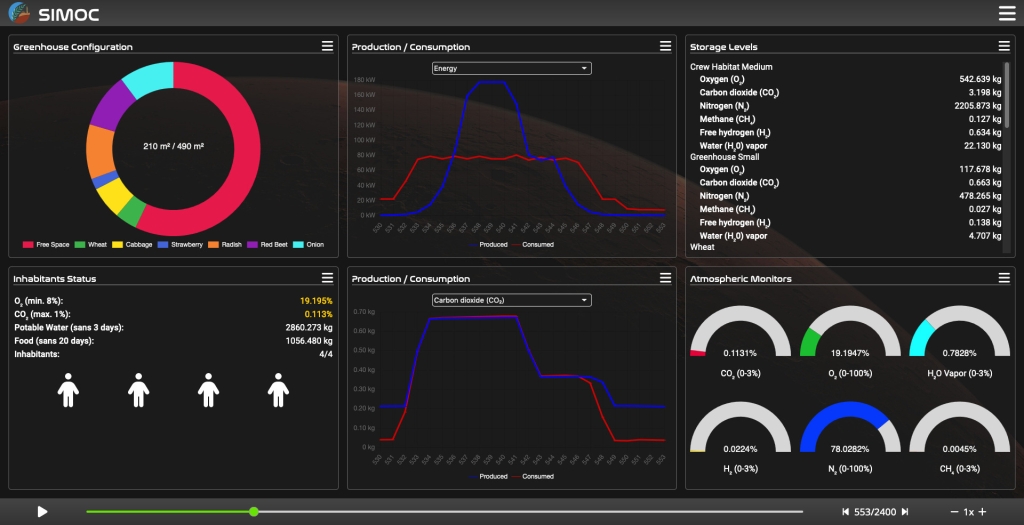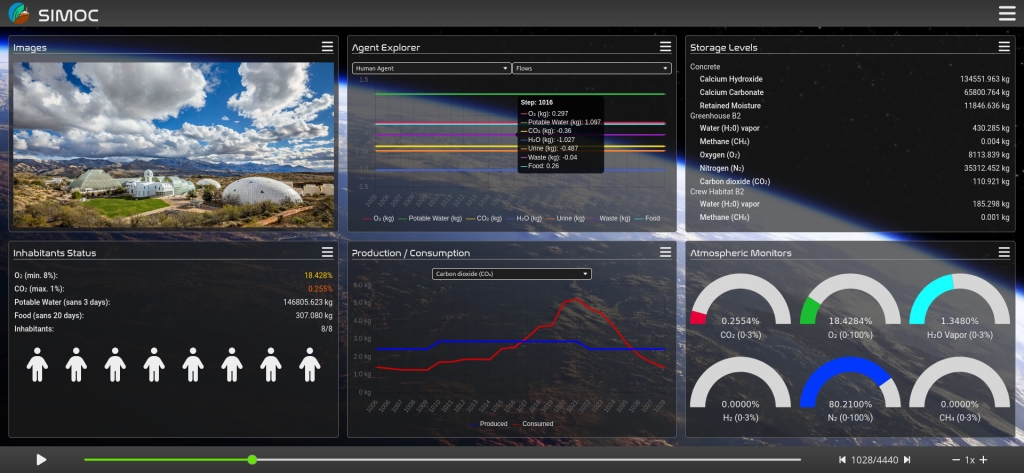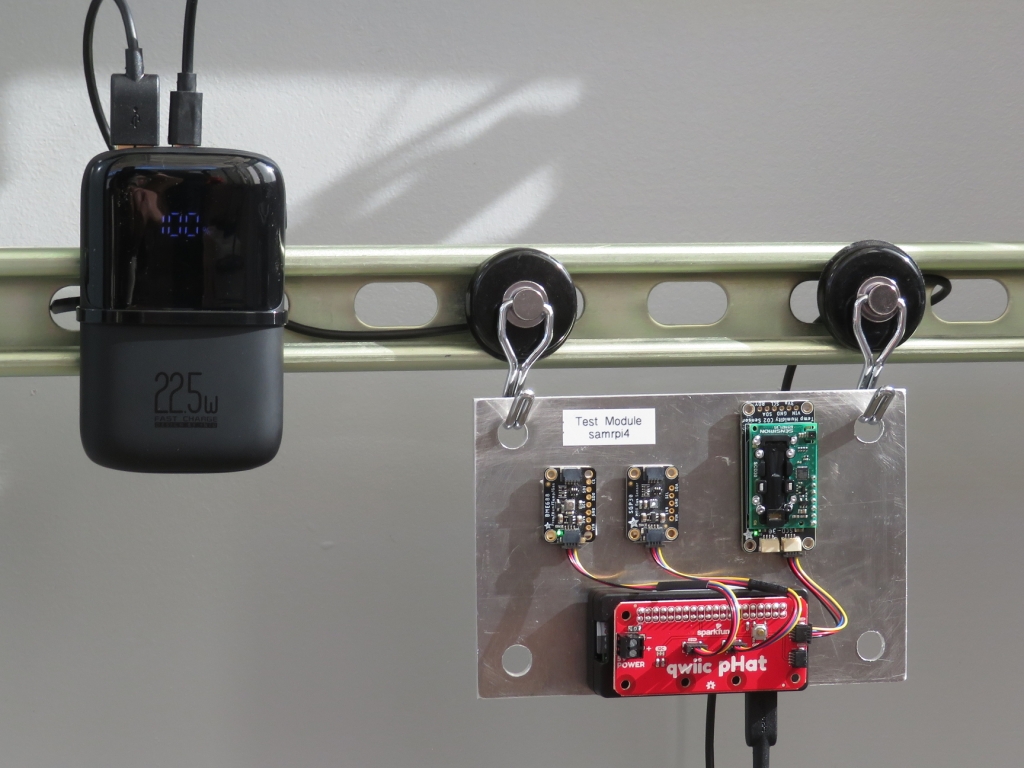SIMOC and SIMOC Live
SIMOC began as a hi-fidelity, agent-based model simulation of a habitat on Mars. It has expanded to include data-based simulations of the two Biosphere 2 missions (1991-93, 1994) in both standard desktop and kiosk mode. SIMOC Live is a separate application that enables real-time monitoring and data collected from a growing list of environmental sensors. Each of these is described in greater detail below.

SIMOC Mars
SIMOC is the original computer model and simulation of a habitat on Mars. It has been in development since 2017, starting with a robust dataset extracted from the NASA Baseline Values and Assumptions (BVAD) document and plant research by Dr. Ray Wheeler and his colleagues. SIMOC development continues to this day, with improvements in performance, high fidelity simulation, and a closer approximation to the real world as the development team integrates new research, publishes peer reviewed papers, and integrates data acquired from SAM, the Mars habitat analog at Biosphere 2.
The simulation of a near-future Mars habitat, the Space Analog for the Moon & Mars (SAM), and Biosphere 2 are integrated into the SIMOC web interface and readily available to you. Visit the First Time User page to get started.

SIMOC B2
In the summer of 2022 National Geographic Society and Biosphere 2 (B2) jointly funded the development of a new simulation for SIMOC. Lead by developer Grant Hawkins, SIMOC B2 incorporates data and experience from the first (1991-93) and second (1994) B2 sealed missions. By programming agents for each of the B2 biomes (rain forest, ocean, savanna, desert, and agriculture further defined by key food cultivars), concrete, and microbial activity in the rich soil, this model successfully demonstrates how the first mission was challenged by a diminishing oxygen supply.
The second mission learned from the first, modified many of its experimental parameters (e.g. reducing the crew by one, managing the crops in a different manner, covering much of the exposed concrete with a seal) and was able to improve the operational functions. This too is accurately modeled.
Citizen scientists, students, any user can then modify SIMOC’s configuration parameters to experiment with the ratio of the biomes, alter the balance of food cultivars, and reduce the amount of curing concrete. What has too often been called a “failure” (there is no such thing as a failed experiment if something new is discovered) is instead a powerful learning experience, as were the real Biosphere 2 missions!
The simulation of a near-future Mars habitat, the Space Analog for the Moon & Mars (SAM), and Biosphere 2 are integrated into the SIMOC web interface and readily available to you. Visit the First Time User page to get started, and then the Advanced User Presets for Biosphere 2 page to learn more.
SIMOC Kiosk
The SIMOC Kiosk mode is built-in to every installation and activated by a key-stroke. The “kiosk” mode offers full-screen, no keyboard entry for guided or unguided learning in a public space. The Arizona Science Center, Phoenix, Arizona has installed an interactive SIMOC exhibit on their technology engagement floor, and is the world’s first science center to bring SIMOC to its visiting citizen scientists.
To bring SIMOC to your science center, please contact us.

SIMOC Live
SIMOC Live was developed in concert with the construction of SAM, a Space Analog for the Moon and Mars at the world-renowned University of Arizona Biosphere 2. SAM was born of a research project in plant biomass accumulation to generate a new dataset for SIMOC. When SIMOC inventor and project lead Kai Staats lived and worked onsite at Biosphere 2 in early 2019, he recognized an opportunity to bring SIMOC to life—to build a hermetically sealed, pressurized Mars habitat analog and thereby validate the SIMOC model in an unfolding series of experiments in bioregeneration studies.
Now, SIMOC and SAM are tightly integrated. SIMOC Live provides SAM with real-time monitoring of critical atmospheric components (CO2, RH, temp, pressure, and VOCs) and in turn, SIMOC benefits from model validation through real-world data acquisition and training. SIMOC Live is readily integrated with Adafruit and Vernier brand sensors in a local, real-time research environment.
Learn how middle school teacher Gretchen Hollingsworth applied an early prototype of SIMOC Live in her classroom.
Learn about CO2 analysis and relative humidity analysis with SIMOC Live at SAM.
Build your own SIMOC Live sensor array
SIMOC Live is fully open source and can be downloaded from github for local installation on your laptop or desktop computer.
You can build your own SIMOC Live sensor array with just a few parts from Adafruit, as follows:
-
- Raspberry Pi Zero 2W with Header: PID 6008
- SparkFun Qwiic pHAT v2.0 for Raspberry Pi: PID 5142
- Adafruit BME688 – Temperature, Humidity, Pressure and Gas Sensor: PID 5046
- Adafruit SCD-30 – NDIR CO2 Temperature and Humidity Sensor: PID 4867
- Adafruit SGP30 Air Quality Sensor Breakout – VOC and eCO2: PID 3709
- STEMMA QT / Qwiic JST SH 4-Pin Cable* – 50mm PID: 4399
- Also needed are a MicroSD card, Micro USB charger and cable
* The Qwiic cables may vary in length depending on how you arrange your sensors, in close proximity to the Raspberry Pi Zero, or at a distance. You’ll need one cable for each sensor.

